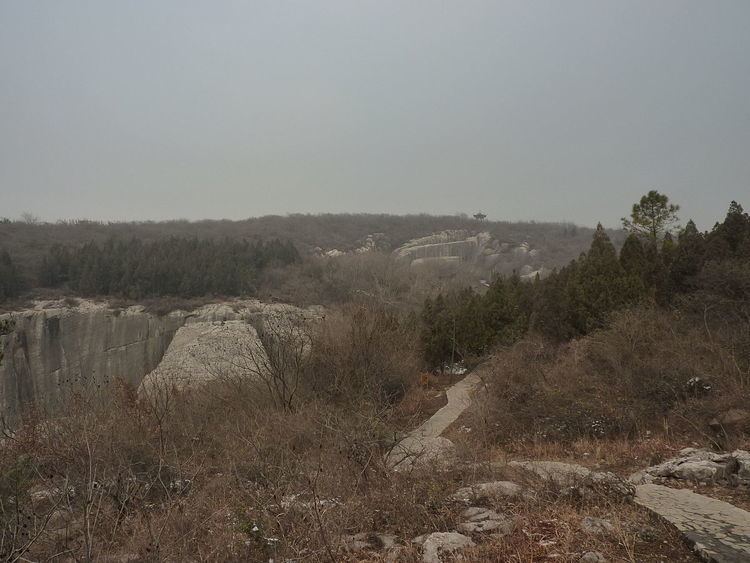Phone +86 25 8411 0582 | ||
 | ||
Similar Former Residence of Gan Xi, Zhan Garden, Chaotian Palace, National Revolutionary Army Me, Tangzi Street Taipingtia | ||
Unfinished giant stele in yangshan quarry
The Yangshan Quarry (Chinese: 阳山碑材; pinyin: Yángshān bēi cái; literally: "Yangshan Stele Material") is an ancient stone quarry near Nanjing, China. Used during many centuries as a source of stone for buildings and monuments of Nanjing, it is preserved as a historic site. The quarry is famous for the gigantic unfinished stele that was abandoned there during the reign of the Yongle Emperor in the early 15th century. In scope and ambition, the stele project is compared to other public works projects of Yongle era, which included the launching of the Treasure Fleet for the Zheng He expeditions and the construction of the Forbidden City in Beijing.
Contents
- Unfinished giant stele in yangshan quarry
- Xiajin machinery xj968 28 block handler working at yangshan quarry in guangdong province
- LocationEdit
- HistoryEdit
- Present dayEdit
- LiteratureEdit
- References
Xiajin machinery xj968 28 block handler working at yangshan quarry in guangdong province
LocationEdit
The Yangshan Quarry is situated on the Yangshan Mountain (elevation 140 m), also known as Yanmen Shan (雁门山), northwest of Tangshan Town (汤山镇). The Yangshan is the main peak of the Kongshan Mountain Range (孔山山脉). The site is located 15–20 km to the east from the eastern part of Nanjing City Wall and the Ming Xiaoling Mausoleum. Administratively, the area is in the Jiangning District of Nanjing City, Jiangsu Province.
HistoryEdit
The Yangshan Quarry has been worked from the time of the Six Dynasties, the local limestone being used for construction of buildings, walls, and statues in and around Nanjing.
After Zhu Yuanzhang (the Hongwu Emperor) founded the Ming dynasty in 1368, the city of Nanjing became the capital city of his empire. The Yangshan quarry became the main source of stone for the major construction projects that changed the face of Nanjing. In 1405, Hongwu's son, the Yongle Emperor, ordered the cutting of a giant stele in this quarry, for use in the Ming Xiaoling Mausoleum of his deceased father. In accordance with the usual design of a Chinese memorial stele, three separate pieces were being cut: the rectangular stele base (pedestal), the stele body, and the stele head (crown, to be decorated with a dragon design). After most of the stone-cutting work had been done, the architects realized that moving stones that big from Yangshan to Ming Xiaoling, let alone installing them there in a proper way, would not be physically possible. As a result, the project was abandoned. In place of the stele, a much smaller tablet (still, the largest in the Nanjing area), known as the Shengong Shengde ("Divine Merits and Godly Virtues") Stele was installed in Ming Xiaoling's "Square Pavilion" (Sifangcheng) in 1413.
The three unfinished stele components remain in Yangshan Quarry to this day, only partially separated from the living rock of the mountain. The present dimensions and the usual weight estimates of the steles are as follows:
According to experts, if the stele had been finished and put together, by installing the stele body vertically on the base, and topping with the stele head, then it would have stood 73 meters tall. For comparison, the Shengong Shengde Stele actually installed in Ming Xiaoling is 8.78 m tall (6.7 m body + crown, on top of a 2.8 m tall tortoise pedestal). The Song-dynasty (early 12th century) Wan Ren Chou ("Ten Thousand Men's Sorrow") Stele in Qufu, which is thought to be one of the tallest in China, is 16.95 m tall, 3.75 m wide, 1.14 m thick.
Present dayEdit
In 1956, the Yangshan Quarry was entered on the Jiangsu provincial register of protected cultural monuments. It is maintained as a tourist site, although, according to journalists who visited it at the turn of the 21st century, the site was little known even in Nanjing itself, and had few visitors.
A small theme park called the Ming Culture Village (明文化村, Míng Wénhuà Cūn) was constructed at the entrance to the site; as of 2011, it has a stage, children's rides, and various history-themed amusements. A single admission ticket allows one to visit the "village" and then to walk some 300–400 m to the quarry proper on one of several forest trails. The site is open year-round, but still is mostly deserted in winter.
Transportation from Nanjing to the Yangshan Quarry (either directly to the Ming Culture Village's entrance plaza, or to the "Yangshan Quarry" stop on the Jiangsu Provincial Highway 122 (S122)) is provided by several bus routes, including the Nanjing-Tangshan Line (南汤线, Nán-Tāng Xiàn) from the Nanjing Railway Station.
